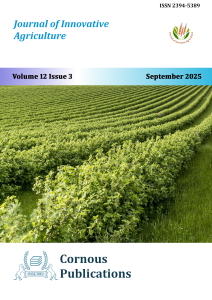Background: Agriculture is a primary livelihood provider in India, sustaining over 58% of rural households, with banana ranking as the country's second most significant fruit crop after mango. Banana cultivation spans 3.8 million hectares across 122 countries, with India contributing approximately 25.7% to global production. Crop yield prediction using machine learning techniques can optimize field operations and support pre-harvest planning decisions for farmers.
Methods: The study evaluated machine learning models for predicting banana crop yields across 31 districts of Tamil Nadu, India. Historical yield data from 2011-2018 were collected from governmental sources, with rainfall data from 2016-2018. After data preparation and pre-processing, three regression techniques, Multiple Linear Regression, Random Forest Regression, and Polynomial Regression, were implemented and compared. Multiple Linear Regression was selected to establish baseline linear relationships between cultivation parameters and yield outcomes, providing interpretable coefficients for agricultural decision-making. Random Forest Regression was chosen for its superior ability to capture complex non-linear interactions between multiple agricultural variables and handle real-world data inconsistencies in datasets. Polynomial Regression was utilized to examine non-linear relationships in the data, specifically curved patterns between cultivation area size and yield performance. The models were trained on key agricultural parameters, including cultivation area, productivity metrics, and rainfall patterns.
Results: Analysis revealed a weak negative correlation between cultivation area and productivity, with smaller areas (under 6000 Ha) achieving some of the highest productivity levels (70-90 tonnes / ha). Rainfall showed minimal impact on productivity, suggesting effective irrigation systems and water management practices in the region. The Random Forest model demonstrated superior performance with a 36% higher Root Mean Square value compared to other models. Polynomial Regression proved less effective due to data nonlinearity, while Multiple Linear Regression provided straightforward predictions but with lower accuracy.
Conclusion: The study confirms that Random Forest Regression is the most effective machine learning technique for banana yield prediction in Tamil Nadu's agricultural context. The findings suggest that successful banana cultivation in the region relies more on intensive farming practices in smaller areas rather than extensive cultivation.
Background: The purpose of this study was to determine the lethal dose given by the chemical mutagen ethyl-methane sulfonate (EMS) in the high-yielding rice variety ADT43. The frequency of chlorophyll mutations has been analysed in the M2 generation.
Methods: A pilot study that consisted of treating ten batches of rice seeds using different dosages of ethyl methane sulphonate (EMS) and conducting kill curve analysis was used to determine lethal doses. The M1 population was then divided into three batches, each with EMS dosages of 0.4%, 0.5%, and 0.6%. Three batches of the M2 population, involving the 700, 700, and 700 M2 families, were subsequently exposed to chlorophyll mutation in the subsequent cropping and studied.
Result: The range of the LD50 value is 0.4% to 0.6% EMS. The lethality of the rice increased linearly with a gradual increase in the EMS dosage. At EMS dosages of 0.4%, 0.5%, and 0.6%, the rates of the chlorophyll mutation were 4, 4.57, and 6.14, respectively.
Conclusion: Since the presence of chlorophyll mutants in the M2 generation is confirmed, the reliability of the mutant population is verified to utilise this mutant population to screen for the trait of interest.
